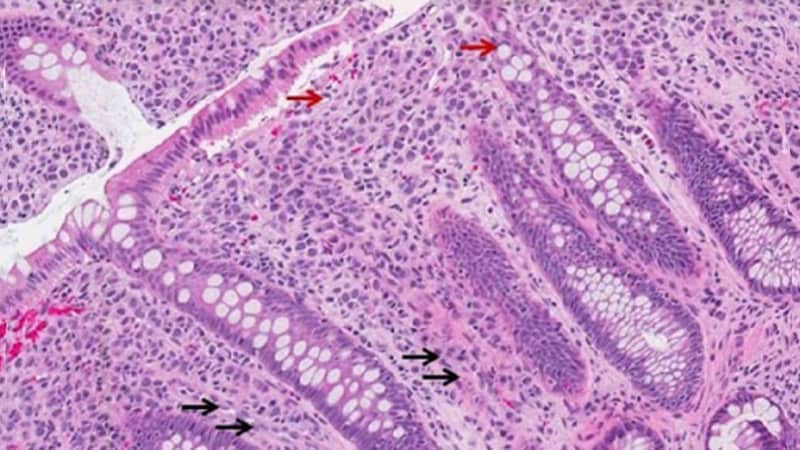Identification of a New Hereditary Lobular Breast Cancer Syndrome Linked to CDH1 Gene Variants
Core Concepts
Pathogenic variants in the CDH1 gene are associated with a new form of hereditary lobular breast cancer (HLBC) that is distinct from the better-known breast-ovarian syndrome linked to BRCA1 and BRCA2 alterations.
Abstract
This study investigated the frequency of germline CDH1 variants in women with lobular breast cancer (LBC) who met the clinical criteria for HLBC. The researchers analyzed a single-center cohort of nearly 5,500 primary lobular breast tumors, of which 34.4% presented the hereditary phenotype.
Key findings:
Germline testing identified 15 CDH1 variants in 15 unrelated families. No germline variants of BRCA1 and BRCA2 were found in CDH1 variant carriers.
The overall frequency of CDH1 germline variants was approximately 4%, with 1.5% being pathogenic or likely pathogenic.
CDH1 variants were associated with an age ≤ 45 years at lobular tumor diagnosis and a positive family history of breast cancer.
Somatic analysis showed structural alterations of the second CDH1 allele as the main mechanism of HLBC tumorigenesis, suggesting potential for new therapeutic biomarkers.
The authors emphasize the importance of considering CDH1 testing in young women, those with bilateral lobular cancer, or those with a positive family history of breast cancer, and starting gastroscopy screening programs for these individuals due to the risk of gastric cancer.
CDH1 Linked With New Hereditary Breast Cancer Syndrome
Stats
34.4% of 5,500 primary lobular breast tumors presented the hereditary phenotype.
15 germline CDH1 variants were identified in 15 unrelated families.
The overall frequency of CDH1 germline variants was approximately 4%, with 1.5% being pathogenic or likely pathogenic.
CDH1 variants were associated with an age ≤ 45 years at lobular tumor diagnosis and a positive family history of breast cancer.
Quotes
"Pathogenic or likely pathogenic germline CDH1 variants are associated with risk for diffuse gastric cancer and lobular breast cancer in the so-called hereditary diffuse gastric cancer [HDGC] syndrome. However, in some circumstances, LBC can be the first manifestation of this syndrome in the absence of diffuse gastric cancer manifestation."
"Forty percent of CDH1 variants were pathogenic or probably pathogenic. Another 40% were represented by variants of unknown significance, which may be reclassified over time, and the rest were benign."
Key Insights Distilled From
by Cristina Fer... at www.medscape.com 05-17-2024
https://www.medscape.com/viewarticle/cdh1-linked-new-hereditary-breast-cancer-syndrome-2024a10009fr
Deeper Inquiries
What are the potential implications of this new hereditary lobular breast cancer syndrome for early detection, prevention, and treatment strategies?
The identification of a new hereditary lobular breast cancer (HLBC) syndrome linked to pathogenic variants of CDH1 has significant implications for early detection, prevention, and treatment strategies. Early detection can be improved by considering specific criteria such as age (<45 years), a positive family history of breast cancer, or bilateral lobular cancer manifestation when deciding to perform CDH1 testing in women with breast cancer. This targeted approach can lead to the identification of individuals at higher risk for HLBC, enabling earlier interventions and personalized treatment plans. Prevention strategies may involve implementing risk screening programs for relatives of individuals with pathogenic CDH1 variants to identify at-risk individuals and provide them with appropriate surveillance and preventive measures. In terms of treatment, understanding the genetic basis of HLBC can lead to the development of targeted therapies and the identification of new therapeutic biomarkers, potentially improving outcomes for patients with this syndrome.
How do the clinical and genetic characteristics of this HLBC syndrome compare to other known hereditary breast cancer syndromes, and what are the key differences?
The clinical and genetic characteristics of the HLBC syndrome associated with CDH1 pathogenic variants differ from other known hereditary breast cancer syndromes, such as those linked to BRCA1 and BRCA2 alterations. While BRCA1 and BRCA2 mutations are well-established genetic markers for hereditary breast-ovarian cancer syndromes, CDH1 variants are now recognized as identifying a distinct form of hereditary lobular breast cancer. Key differences lie in the specific cancer types associated with each syndrome, with CDH1 variants being linked to lobular breast cancer and diffuse gastric cancer in the hereditary diffuse gastric cancer (HDGC) syndrome. In contrast, BRCA1 and BRCA2 mutations are primarily associated with breast and ovarian cancers. Additionally, the age of onset, family history patterns, and tumor characteristics may vary between these syndromes, highlighting the importance of accurate genetic testing and tailored management strategies based on the specific genetic profile of the individual.
Given the association with gastric cancer risk, what are the optimal screening and management protocols for individuals with pathogenic CDH1 variants, and how can these be effectively implemented in clinical practice?
Individuals with pathogenic CDH1 variants are at an increased risk of developing diffuse gastric cancer in addition to lobular breast cancer. Optimal screening and management protocols for these individuals should include regular gastroscopies to monitor for early signs of gastric cancer. It is crucial to establish a specific screening program that incorporates gastroscopies for individuals with CDH1 variants, as the risk for gastric cancer cannot be excluded. Additionally, risk screening programs for relatives of individuals with pathogenic CDH1 variants should be considered to identify at-risk individuals and provide them with appropriate surveillance and preventive measures. These protocols can be effectively implemented in clinical practice by raising awareness among healthcare providers about the association between CDH1 variants and gastric cancer risk, promoting genetic testing for individuals with specific clinical criteria, and ensuring access to specialized screening and management services for individuals at higher risk for HLBC and associated cancers.
0
